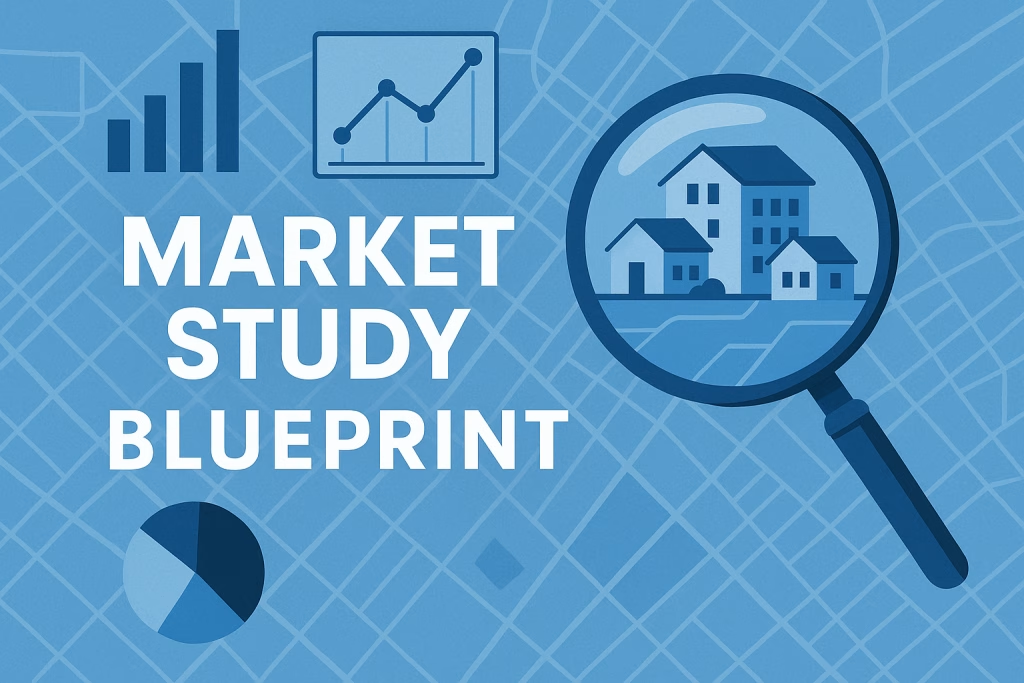Introduction
Overview of Market Study Blueprint
Market Study Blueprint is your ultimate roadmap to mastering real estate investments through strategic, data-driven insights. In today’s fast-paced property markets, knowing exactly who’s buying, what they value, and where trends are heading can make or break your success. Imagine pinpointing emerging neighborhoods in Cairo before the competition, forecasting rental yields with machine-learning precision, and sidestepping costly pitfalls—all by following one clear, proven blueprint.
A well-structured market study blueprint serves as the foundation for effective real estate analysis. It encompasses defining objectives, identifying target demographics, and collecting vital data about current market conditions.

A streamlined market study format should include key components such as:
- Objective of the study
- Geographic area of interest
- Economic indicators
- Competitor analysis
- Buyer behavior insights
Significance of Market Study in Real Estate
Understanding market study is crucial for real estate professionals. It allows investors and developers to identify opportunities, minimize risks, and make informed decisions. For example, while evaluating a new market in Egypt, successful investors often rely on market studies to:
- Assess property valuations
- Anticipate market trends
- Determine the viability of development projects
In this ever-evolving landscape, acknowledging the importance of a comprehensive market analysis can lead to substantial benefits, making it a non-negotiable aspect of real estate investments.
Understanding Market Study
Definition and Purpose of Market Study
A market study is a comprehensive analysis aimed at understanding the dynamics of a specific market segment. Its purpose is to gather data about consumer behaviors, market trends, and competitive landscapes, enabling stakeholders to make informed decisions. Essentially, it’s a roadmap that guides real estate investments and development projects.
For instance, if an investor evaluates a new commercial project, the market study will reveal:
- Demand for specific property types
- Current market prices
- Local economic conditions
Benefits of Conducting Market Study
Conducting a market study offers invaluable benefits, such as:
- Risk Mitigation: Identifying potential pitfalls before committing resources.
- Enhanced Investment Decisions: Aligning property investments with market demand, ensuring higher returns.
- Strategic Planning: Crafting targeted marketing strategies based on consumer insights.
By investing time in a thorough market study analysis, investors can not only safeguard their investments but also enhance their overall strategic approach in real estate.

Steps to Conduct a Market Study
Identifying the Study Area
The first step in conducting a market study is identifying the study area. This requires precise mapping of geographic boundaries that align with your investment goals. For example, when considering a real estate venture in Cairo, focusing on emerging neighborhoods can uncover lucrative opportunities. How to Conduct a Real Estate Market Study: The Perfect Guide!
Key considerations include:
- Demographic trends: Assess population growth and diversity
- Economic drivers: Identify sectors contributing to local job growth
Collecting and Analyzing Market Data
Once the study area is established, the next step is collecting and analyzing relevant market data. This can involve:
- Conducting surveys to gauge consumer preferences
- Analyzing historical sales data and current listings
- Reviewing zoning laws and regulations
This empirical approach offers a solid foundation for decision-making.
Interpreting Findings and Making Recommendations
Finally, interpreting the findings is crucial. This step involves synthesizing data into actionable recommendations. Investors should aim to:
- Identify potential investment opportunities
- Recommend property enhancements based on consumer preferences
Through this structured approach, stakeholders can gain a clear understanding of the market landscape, ultimately driving informed real estate decisions.
Tools and Methods for Market Analysis
SWOT Analysis in Real Estate
A powerful tool for market analysis is the SWOT analysis, which assesses the Strengths, Weaknesses, Opportunities, and Threats in a real estate context. For instance, a developer might identify strengths like a prime location while recognizing weaknesses such as aging infrastructure.
Typical factors include:
- Strengths: Unique property features
- Weaknesses: Market restrictions
- Opportunities: Emerging trends in sustainability
- Threats: Increasing competition
Comparative Market Analysis (CMA)
Next, the Comparative Market Analysis (CMA) provides insights into property values by comparing similar listings. This method involves evaluating recent sales, active listings, and expired listings to establish accurate pricing strategies. A well-done CMA can support negotiations and help sellers price their properties competitively.
Trends and Forecasting Techniques
Finally, leveraging trends and forecasting techniques is vital for anticipating market movements. This may involve utilizing:
- Historical data analysis for spotting patterns
- Market sentiment surveys to gauge buyer interests
By combining these tools, real estate professionals can navigate complex markets more effectively and make data-driven decisions that enhance investment potential.

Application of Market Study in Real Estate Investment
Evaluating Property Investment Opportunities
The application of market study in real estate investment is instrumental in evaluating property opportunities. Investors can harness insights from market data to pinpoint properties that align with their financial goals. For example, an investor considering a multifamily building might analyze vacancy rates, rental prices, and neighborhood growth trends to determine profitability.
Key evaluation criteria include:
- Cash flow projections: Estimating potential income
- Market demand: Understanding tenant preferences
- Competitive analysis: Assessing similar property performance
Market Study for Development Projects
Furthermore, market studies play a critical role in guiding development projects. By assessing local demand for housing or commercial spaces, developers can ensure their projects meet market needs. For instance, a developer embarking on a new condominium project in a high-demand area can use market studies to determine optimal unit sizes and amenities.
This strategic approach enables informed decisions that minimize risk and maximize success, ultimately making market studies an invaluable asset in the real estate investment landscape.

Case Studies and Real-life Examples
Successful Implementation of Market Study
In real estate, practical case studies illustrate the successful implementation of market studies. Take, for instance, a residential developer in Alexandria, who conducted a detailed market study before launching a new housing community. By analyzing demographic trends and buyer preferences, the developer tailored the project to include family-friendly amenities, resulting in high demand and rapid sales.
Essential components considered included:
- Local school ratings
- Proximity to public transport
- Green spaces for recreation
Lessons Learned from Market Study in Real Estate
However, real-life examples also shed light on lessons learned. For example, a commercial real estate firm underestimated the impact of e-commerce on local retail markets. Their findings illustrated that without properly assessing shifting consumer behaviors, investments could result in vacant storefronts.
Crucial takeaways include:
- Continuously updating market data
- Staying attuned to economic shifts
These insights underline the importance of a thorough, ongoing market study process to adapt to ever-evolving real estate landscapes.

Challenges and Considerations
Common Pitfalls in Market Analysis
Navigating market analysis presents several challenges that can lead to common pitfalls. One notable pitfall is relying on outdated data; real estate markets fluctuate rapidly, making historical data less relevant. For example, an investor who based decisions on a five-year-old report may find the market completely transformed.
Key pitfalls to avoid include:
- Overgeneralization: Assuming trends are uniform across regions
- Ignoring stakeholder input: Failing to gather insights from local community members
- Neglecting qualitative data: Overlooking consumer sentiments and preferences
Regulatory Factors Influencing Market Studies
Additionally, regulatory factors can significantly impact market studies. Changes in zoning laws, building codes, and environmental regulations may affect project feasibility. Understanding local regulations is essential; for instance, a developer in Cairo must comply with stringent guidelines affecting land use and permits.
Integrating awareness of these regulations into the market study process helps identify potential roadblocks, ensuring that stakeholders can navigate the complexities of real estate development more effectively. A proactive approach to these challenges can set the stage for a successful and sustainable investment in the real estate market.

Future Trends in Real Estate Market Analysis
Technology Advancements in Market Research
As the real estate landscape evolves, technology advancements significantly enhance market research capabilities. Innovative tools like geographical information systems (GIS) and big data analytics allow investors to visualize market trends and make data-driven decisions with ease. For instance, a property developer might use GIS to identify up-and-coming neighborhoods that fit their investment strategy.
Key technological trends include:
- Cloud-based platforms: Facilitating real-time data access
- Mobile applications: Offering on-the-go insights for investors
- Virtual reality: Creating immersive property tours for potential buyers
Predictive Analytics and Machine Learning in Real Estate
Moreover, predictive analytics and machine learning are paving the way for smarter investment strategies. By analyzing historical data, these tools can forecast future property values and market trends with impressive accuracy.
For instance, a real estate firm might leverage machine learning algorithms to predict demand for specific property types based on demographic shifts and economic indicators. These advanced technologies not only enhance the precision of market studies but also empower stakeholders to stay ahead of the curve in an increasingly competitive environment, making them indispensable for any serious real estate investor.
Conclusion
Recap of Market Study Essentials
In a rapidly changing real estate landscape, understanding the core components of a market study is essential. From evaluating demographic trends and conducting thorough data analysis to recognizing regulatory influences, each step plays a crucial role in making informed investment decisions. As demonstrated throughout this discussion, a structured market study not only identifies opportunities but also mitigates risks.
Final Tips for Effective Market Analysis
To conclude, here are some final tips for conducting effective market analysis:
- Stay proactive: Regularly update your market data to reflect current conditions.
- Engage local experts: Their insights can reveal nuances that data alone may miss.
- Leverage technology: Utilize modern tools and analytics for enhanced accuracy.
By embracing these practices, real estate professionals can navigate complexities and elevate their investment strategies successfully, ensuring a more prosperous journey in the real estate market.
Start Your Custom Market Study Today
Q&A Section
Q1: What is a real estate market study?
A market study is a comprehensive analysis of consumer behavior, economic factors, and competitive dynamics within a specific geographic area. It provides stakeholders with data to make informed decisions on property investments and development projects netquest.com.
Q2: Why is conducting a market study important?
Performing a market study helps mitigate risks, align investments with demand, and craft targeted strategies—ultimately boosting returns and reducing costly missteps netquest.com.
Q3: What are the core components of a real estate market study?
Objectives and scope
Geographic mapping and demographic trends
Economic indicators (e.g., GDP, employment)
Competitor and comparative market analysis (CMA)
Buyer behavior and demand forecasts
Regulatory and zoning considerations
Q4: How do I conduct a real estate market study?
Define objectives and study area boundaries.
Collect primary data (surveys, focus groups) and secondary data (MLS, government stats).
Analyze data using SWOT, CMA, and forecasting techniques.
Interpret findings into actionable recommendations for investments or development netquest.com.
Q5: Which tools and methods are best for market analysis?
Industry-standard tools include GIS platforms for mapping, big-data analytics for trend spotting, SWOT matrices for strategic insight, and CMAs for property valuation comparisons (as outlined in our “Tools and Methods” section).


